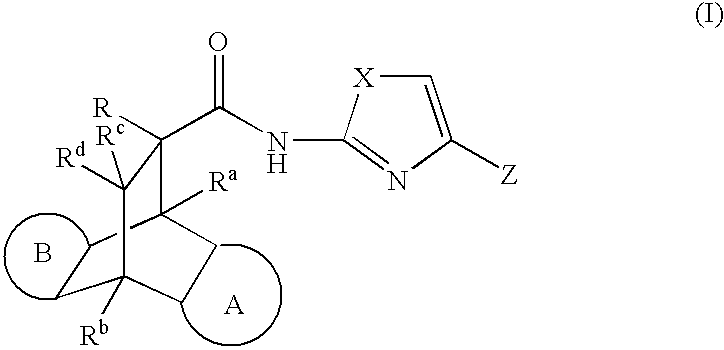Modulators of the glucocorticoid receptor, AP-1, and/or NF-kappaB activity and use thereof
a technology which is applied in the field of new nonsteroidal compounds, can solve the problems of limited systemic use of glucocorticoid receptor and ap-1
- Summary
- Abstract
- Description
- Claims
- Application Information
AI Technical Summary
Benefits of technology
Problems solved by technology
Method used
Image
Examples
preparation 1
[0303]
Ref: B. Bacle and G. Levesque, Polymer Communications, 28, 36 (1987).
[0304]A 75 ml sealed tube was charged with 9-nitroanthracene (10 g, 0.045 mol, 1.0 equi.), hydroquinone (0.5 g, 0.0045 mol, 0.1 equi.), methacrylic acid (39 g 0.45 mol, 10.0 equi.) and xylene (5 mL). The reaction was heated at 160° C. for 24 hours. The solution was cooled and concentrated in vacuo. The residue was dissolved in ethyl acetate and extracted with 1N NaOH (3×). The aqueous phase was acidified with 1N HCl, and the product was extracted with ethyl acetate (3×). The combined organic phases were concentrated in vacuo to give the crude product mixture. The preparative HPLC (column: YMC, C-18 Ballistic, 30×100 mm; 10-90% aq CH3OH / 0.1% TFA, 25 mL / min. flow rate, 220 nm detection wavelength, same for other compounds unless noted) purification yielded the meta-isomer 1a as a white solid, (8.21 g, 59.3% yield). LC / MS (m / z 308.3 (M−H)+); HPLC (Column: Shimadzu VP-0DS, C-18 Ballistic; 10-90% aq CH3OH / 0.1% H3P...
preparation 2
[0307]
Step 1
[0308]A solution of the commercially available 2-amino-thiazole-4-carboxylic acid ethyl ester 2a (3.8 g, 22 mmol) and trityl chloride (6.8 g, 24.3 mmol) in 30 ml pyridine was stirred at room temperature for 16 hours. The precipitate was filtered off and the filtrate was concentrated to reduce the volume to 20 ml. To the crude 2-(trityl-amino)-thiazole-4-carboxylic acid ethyl ester in 20 ml pyridine was added a solution of sodium hydroxide (5.4 g) in 50 ml of 60% ethanol in water. The reaction mixture was stirred at room temperature over the weekend, and was then acidified with acetic acid to pH 5. The precipitate was collected and dried to give 2-(tritylamino)-thiazole-4-carboxylic acid as a white solid (6.1 g, 72% yield). LC / MS (m / z 385.08 (M−H)+); HPLC Rt: 3.732 min.
Step 2
[0309]To a solution of 2-(trityl-amino)-thiazole-4-carboxylic acid (400 mg, 1.03 mmol) in DMSO (1 ml) was added KOH (215 mg, 1.55 mmol) followed by addition of 1-iodo-propane (263 mg, 1.55 mmol). The ...
example 1
[0314]
[0315]To a solution of the acid of Preparation 1b (30 mg, 0.104 mmol) in CH3CN (1 mL) were added 1-[3-(dimethylamino)propyl]-3-ethylcarbodiimide hydrochloride (EDC) (30 mg, 0.156 mmol) and 1-hydroxy-7-benzotriazole (HOBt) (21 mg, 0.156 mmol). After stirring for 5 minutes, to the solution were added 2-amino-thiazole-4-carboxylic acid propyl ester 2b (40 mg, 0.135 mmol) and diisopropylethyl amine (47 mg, 0.063 ml, 0.364 mmol). The reaction was heated at 90° C. for 18 hours. The crude product mixture was directly purified via preparative HPLC to give the title compound of Example 1 (22 mg, 46% yield). LC / MS (m / z 458.1 (M+H)+); HPLC Rt: 4.102 min.
PUM
| Property | Measurement | Unit |
|---|---|---|
| temperature | aaaaa | aaaaa |
| temperatures | aaaaa | aaaaa |
| volume | aaaaa | aaaaa |
Abstract
Description
Claims
Application Information
 Login to View More
Login to View More - R&D
- Intellectual Property
- Life Sciences
- Materials
- Tech Scout
- Unparalleled Data Quality
- Higher Quality Content
- 60% Fewer Hallucinations
Browse by: Latest US Patents, China's latest patents, Technical Efficacy Thesaurus, Application Domain, Technology Topic, Popular Technical Reports.
© 2025 PatSnap. All rights reserved.Legal|Privacy policy|Modern Slavery Act Transparency Statement|Sitemap|About US| Contact US: help@patsnap.com



